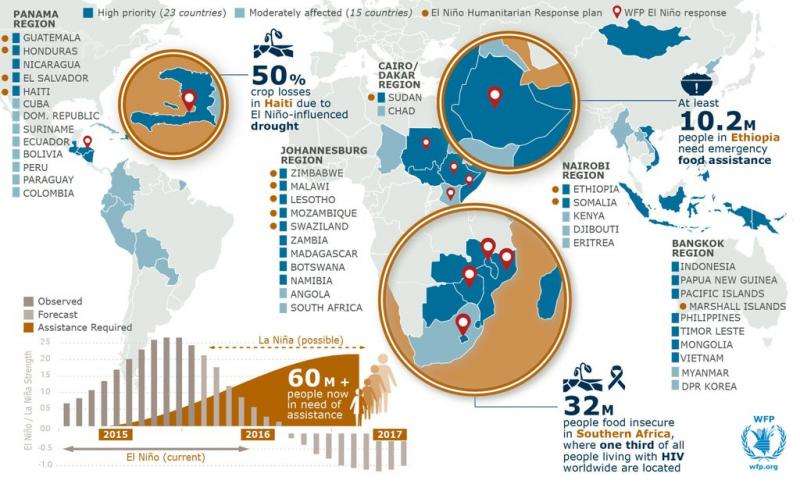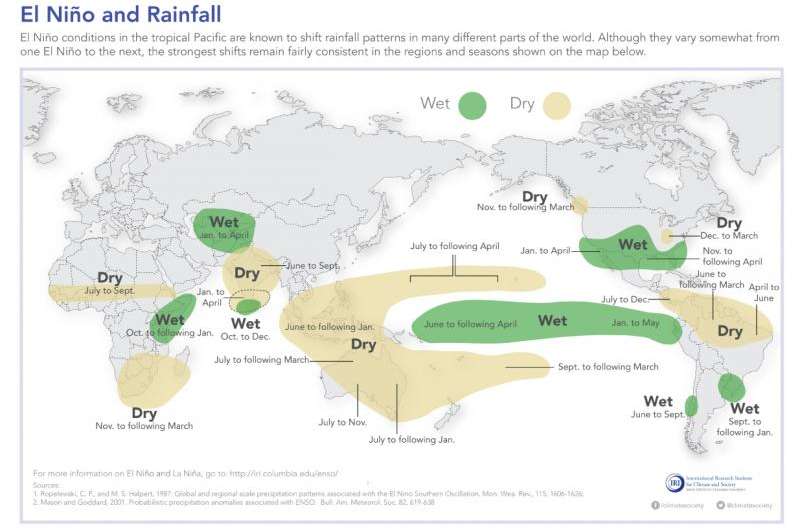Learning from El Niño as La Niña Odds Rise

Although El Niño is weakening, its ramifications continue to be felt around the world. Drought and resulting food insecurity is one of the major implications for southeast Asia, eastern and southern Africa, Central America and the Caribbean. Sixty million are in need of emergency relief today, according to the United Nations.
One of the most hard-hit areas has been Ethiopia, where at least ten million people need emergency food assistance, according to the World Food Programme (see figure). In addition to malnutrition and other ill effects of food insecurity, El Niño also has a myriad of other health impacts that will last through at least the end of 2016, including disease outbreaks and disruption of health services.
Other climate impacts potentially helped along by this El Niño event include floods in Iran, electricity shortages in Venezuela and devastating fires in Indonesia. But not all impacts of El Niño are negative. Some late-season storms, possibly influenced by El Niño, have been welcome in California, which is experiencing exceptional drought conditions in nearly a third of the state.
Some typical El Niño impacts were not seen this year, surprising to some given its strength on par with the other most extreme El Niño events since 1950. While El Niño is one of the most well-understood climate phenomena, scientists still have the need and opportunity to advance our knowledge further, as outlined here by Lisa Goddard, director of the International Research Institute for Climate and Society, at the El Niño 2015 Conference.

The conference, held at the IRI in November of last year, brought together physical scientists, social scientists, forecasters, development professionals and journalists from governments, academia, humanitarian agencies and the private sector to share perspectives on climate services in the past two decades and strategize about the best ways to move forward in increasing climate resilience.
Even as scientists help us understand and better anticipate climate impacts, the task of making that information useful for decision makers is a considerable one. Through showing the depth and breadth of impacts from El Niño, conference presenters made this clear. Preparation and response to El Niño events require significant resources, massive coordination efforts and the flexibility of organizations to work with risk and uncertainty.
Recordings and summaries of the conference's talks and panels, as well as participant interviews, social media interactions and conference feedback are available in the conference's digital report. Other supplementary material from the conference can be found here.
The lessons learned from the conference and from the impacts that have played out during this El Niño are critical for understanding our vulnerability to future climate risks. These risks include long-term climate change as well as other shorter-term variability. The next wide-scale risk for which we have some advance notice is, in fact, potentially right around the corner. According to the latest forecast from IRI and NOAA's Climate Prediction Center, the odds of a La Niña (the opposite phenomenon of El Niño) forming are up to 60 percent towards the end of 2016.
La Niña tends to influence climate in the same areas affected by El Niño (see figures), potentially piling on already-stressed regions with back-to-back years of extreme climate. In the coming months, the La Niña forecast for the rest of the year should become more certain.
More information: For more on El Niño and La Niña, see the IRI's ENSO resource page: "iri.columbia.edu/our-expertise/clima"t
Provided by Columbia University
This story is republished courtesy of Earth Institute, Columbia University: blogs.ei.columbia.edu/ .


















